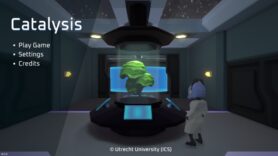Immersive Chemistry Education – Designing an Educational Game
For this project, the team created an educational game for third year chemistry students in collaboration with a serious gaming company. They focused on aligning the learning goals of the Catalysis course with game mechanics through design thinking. Within the game, students can freely study, experiment and rehearse important chemistry and catalysis concepts using simulated examples and digital analytical tools, with direct feedback. The game was well-received by students for its accessibility, engagement and educational value.

Background
The project was started after observing that students frequently experience a gap between their understanding of fundamental theories, the societal context, and the analytical, computational, and materials chemistry methods used in catalysis studies
Digital evaluations from previous years of the Catalysis course at Utrecht University further revealed that students desired a better connection between theory and context, and between lectures and seminars. Teachers also observed that students needed to improve their ability to apply concepts learned during the course to real-world problems in catalysis. This perceived disconnect between theoretical knowledge and its practical application served as the primary impetus for starting the project.
Aims
The project team aimed to improve the interaction between theory and practice, helping students apply chemical concepts to real-world problems and understand how theories are conceived and tested. Their second aim was to give students a more hands-on and intuitive feeling for performing research in catalysis. They also wanted to enhance engagement, and saw potential of digital game-based education to promote experience-based knowledge and foster a state of “flow”, which would be beneficial for learning. This led to the development of a game for the Catalysis course at Utrecht University, designed to enhance intrinsic motivation through interactive, curriculum-connected game mechanics.
Project description
Raccoon Serious Games was consulted, a company specialized in educational game development, to create a game that leaves a lasting impression while aligning with the learning objectives of the course. They advised on the development process using Design Thinking, an iterative approach consisting of six distinct phases:
- Ambition: The team defined the purpose and goals of the project, focusing on how the game could enhance learning within the course.
- Research: They identified the specific learning objectives to be embedded in the game and explored a wide range of game mechanics and narrative possibilities.
- Ideation: From the research outcomes, the most promising ideas were selected and translated that to a game concept.
- Development: Prototypes were created and the team tested game mechanics early in the process based on the concept. This allowed them to quickly identify strengths and weaknesses and assess whether the mechanics effectively supported the learning goals.
- Production: For the technical development of the game, the team partnered with SoftwareProject Informatica, who built a web-based version accessible to both students and teachers across devices.
- Implementation: Finally, they introduced the game in the classroom through the Teaching & Learning Lab, allowing them to evaluate its impact within the actual course context.
Results
The team developed a game in which students play as a researcher aboard a spaceship. Following an asteroid impact that damages their water reservoir, they are tasked to improve the catalytic Sabatier reaction: converting CO2 and H2 into CH4 and essential H2O. While experimenting they learn intuitively about catalysis and important related chemical concepts. Their progress is locked behind a dialogue system with a digital Research Assistant, that checks their knowledge.
This game was successfully implemented in the Catalysis course at Utrecht University. It was well-received by students for its accessibility, engagement, and educational value. Students enjoyed the game and found it engaging, often experiencing a state of “flow” where they lost track of time, indicating enhanced focus during learning. Many students found it an efficient tool for revising and practicing knowledge, particularly helping students apply theoretical concepts in a practical, interactive setting.
The game is valuable for teachers as well: the game records player choices and experimental conditions, providing teachers with insights into student competencies and areas needing further attention. Furthermore we have created a flexible system, allowing customization of difficulty, dialogues, and learning goals for future use and adaptation by educators of other institutes or universities.
Reflections
